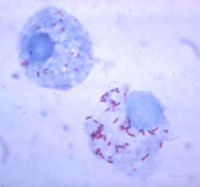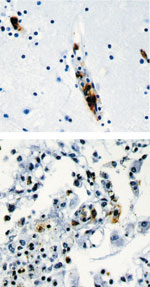Rickettsia rickettsii: Difference between revisions
| Line 45: | Line 45: | ||
==Cell structure and metabolism== | ==Cell structure and metabolism== | ||
[[Image:Rickettsia_rickettsii2.jpg|frame|right| | [[Image:Rickettsia_rickettsii2.jpg|frame|right| Rickettsia in endothelial cells of a blood vessel in the brain. Photo credit: [http://www.cdc.gov/ncidod/eid/vol12no04/05-1282.htm Fatal Human Infection with Rickettsia rickettsii in Yucatán, Mexico.]]] | ||
The Rickettsia rickettsii bacterium are intracellular organisms, and they live in the cytoplasms of host cells sometimes in the nucleus. They are adapted as intracellular organisms because they have transport systems and metabolic enzymes. These microbes divide by binary fission and take about 8 hours to double. [2] | The Rickettsia rickettsii bacterium are intracellular organisms, and they live in the cytoplasms of host cells sometimes in the nucleus. They are adapted as intracellular organisms because they have transport systems and metabolic enzymes. These microbes divide by binary fission and take about 8 hours to double. [2] | ||
Revision as of 00:41, 28 August 2007
A Microbial Biorealm page on the genus Rickettsia rickettsii
Classification
Higher order taxa
Bacteria; Proteobacteria; Alpha Proteobacteria; Rickettsiales; Rickettsiaceae; Spotted fever group
Species
|
NCBI: Taxonomy |
Rickettsia rickettsii
Other Names
synonym: Dermacentroxenus rickettsii
synonym: "Dermacentroxenus rickettsii" Wolbach 1919
synonym: Rickettsia rickettsii (Wolbach 1919) Brumpt 1922
Description and significance

Rickettsia rickettsii is a small, rod-shaped bacterium known to cause Rocky Mountain spotted fever (RMSF). This disease can be transmitted to humans either from a tick bite with an incubation period of 1 week, or by contamination of a cut on the skin or a wound with ticks feces. Dr. Ricketts first isolated this microbe in Montana, 1906. [2] [4]
Describe the appearance, habitat, etc. of the organism, and why it is important enough to have its genome sequenced. Describe how and where it was isolated. Include a picture or two (with sources) if you can find them.
Genome structure
Genes: 1311
Length: 1,257,710 nt
Protein coding: 1311
Structural RNAs: None
GC Content: 32%
% Coding: 77%
Pseudo genes: None
Topology: other
Molecule: DNA
Completed 02/06/2004[3]
Describe the size and content of the genome. How many chromosomes? Circular or linear? Other interesting features? What is known about its sequence? Does it have any plasmids? Are they important to the organism's lifestyle?
Cell structure and metabolism

The Rickettsia rickettsii bacterium are intracellular organisms, and they live in the cytoplasms of host cells sometimes in the nucleus. They are adapted as intracellular organisms because they have transport systems and metabolic enzymes. These microbes divide by binary fission and take about 8 hours to double. [2]
Rickettsia rickettsii are similar to small, gram-negative nods. They are barely visible under a light microscope, and they stain poorly with Gram stains. The cell wall is made up of peptidoglycan, lipopolysaccharide, and a cell membrane. These microbes contain two outer membrane proteins, outer membrane protein A (OmpA) and outer membrane protein B (OmpB). OmpA sticks to the host cell wall, and OmpB is an abundant outer membrane protein that contains sequences related to the typhus group of rickettsiae.[2]
Describe any interesting features and/or cell structures; how it gains energy; what important molecules it produces.
Ecology
Describe any interactions with other organisms (included eukaryotes), contributions to the environment, effect on environment, etc.
Pathology
Typical symptoms of RMSF may include fever, headache, depression, and gradually may develop a skin rash called purpura or petechiae. Serious cases of RMSF can include central nervous system, pulmonary, or hepatic injuries. [2]
How does this organism cause disease? Human, animal, plant hosts? Virulence factors, as well as patient symptoms.
Application to Biotechnology
Does this organism produce any useful compounds or enzymes? What are they and how are they used?
Current Research
Enter summaries of the most recent research here--at least three required
References
1) NCBI Taxonomy Browser "Rickettsia Rickettsii" Retrieved 26 August, 2007
2)Primary Care Update for OB/GYNS, Volume 9, Issue 1, January-February 2002, Pages 28-32 Whitney Jamie
3)http://www.ncbi.nlm.nih.gov/sites/entrez?Db=genome&Cmd=ShowDetailView&TermToSearch=5211
4)http://jmm.sgmjournals.org/cgi/content/full/56/1/138
Edited by Amber Chou; student of Rachel Larsen
Primary Care Update for OB/GYNS, Volume 9, Issue 1, January-February 2002, Pages 28-32
Whitney Jamie
